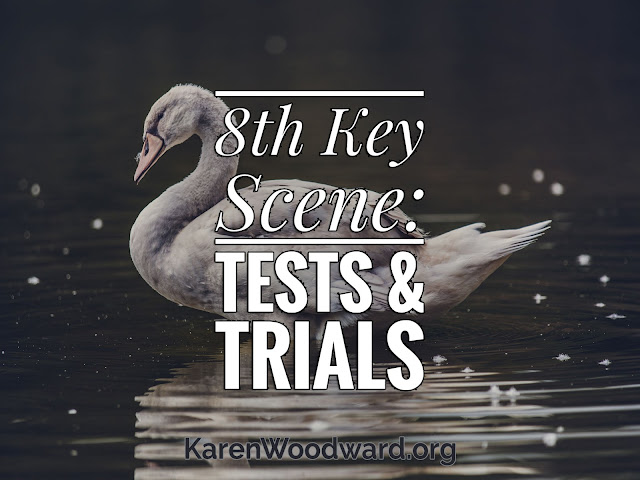“Writing a novel is like driving a car at night. You can only see as far as your headlights, but you can make the whole trip that way.”
In honor of NaNoWriMo, every day this month I’m blogging about a key scene, one that any suspenseful story will include, either implicitly or explicitly. I then take a close look at how this scene, this structure, is implemented in three popular genres: Action, Romance and Mystery. So far I've posted articles about the
Inciting Incident, the
Lock-In,
Tests and Trials,
Pinch Point One, the
Midpoint Crisis, the
All Hope is Lost scene, and
the Climax.
Today I'm going to talk about the Epiphany.
The Epiphany: Breaking It Down
The
All Hope is Lost scene immediately precedes the Epiphany. In that scene, as the name implies, something happens that transforms the protagonist’s world (or perhaps just the protagonist’s view of it) and brings her to her lowest point in the story.
After the All Hope Is Lost moment the B-story is resolved.[3] As a result, an important change occurs in the protagonist and she resolves her
inner conflict. One result of this change is that the protagonist is able to figure out how to turn matters around and make one last desperate attempt to achieve her goal.
About this “important change,” I don't mean a superhuman ability—though, depending on the kind of story this is, it could be! Whatever the change, the ground must have been laid for it. Perhaps the protagonist is now able to think clearly because she finally has the empathy she has been lacking, or perhaps she has been able to release a certain way of thinking that has been holding her back.
Whatever the case, during the Epiphany, something
fundamental within the protagonist
permanently changes and, as a result, she is able to escape from whatever had caused the complete and total destruction of all her previous plans.
Of course, not all protagonists have an internal conflict. If the only conflict is external, the hero can draw upon some characteristic that defines him such as his strength or his knowledge. Indiana Jones in
Raiders of the Lost Ark is a good example of a hero without any real internal conflict. At the end of that movie it is his broad knowledge that saves both himself and Marion, the object of his desire. Jones says: “Marion! Don’t look at it. Shut your eyes, Marion. Don’t look at it, no matter what happens.”
One way of describing the Epiphany is that it’s at this point in the story that the scales drop from the protagonist’s eyes. She thought she knew how things were, but she didn't. To use
Shrek as an example, the ogre thought he knew how the Princess and Donkey felt about him, but he didn't. He thought they believed he was hideous and unlovable but he had misunderstood them. After the All Hope Is Lost point Donkey comes to Shrek and tells him Fiona wasn't calling him ugly and unlovable. Donkey doesn't tell Shrek she was describing herself because that's not his secret to tell. This is when the proverbial scales fall from Shrek's eyes and he realizes he acted like an idiot. Shrek decides to do what he should have done long before—risk rejection and tell Princess Fiona he loves her.
Here's another example: At the end of The Matrix Neo realizes he's the One and that he loves Trinity. At that moment the scales drop from his eyes; he sees what he had been blind to. He finally understands and it is this realization that transforms him. It allows him to do something he wouldn't have otherwise been able to do; namely, triumph over the Matrix and become the One.
I'm not suggesting that this life-transforming moment of self-realization occurs at the end of every story. It doesn't. But it happens often enough that I wanted to mention it.
But, of course, the hero doesn't have to win. Sometimes the revelation comes, but too late. Sometimes the revelation doesn't come at all.
The Epiphany: Key Points
- A significant resolution. We can speak about this resolution in a couple of ways.
Speaking about this resolution using the language of subplots (or, if you prefer, the A-Story, B-Story, C-Story, and so on), this is the place where subplots are cashed out and the various threads of the story merge into one.
Speaking about this in terms of conflict, whether internal or external, this is the place where the conflicts are resolved. Not a final solution or answer, but the various conflicts come together in a synthesis that provides the protagonist with an idea about how to push forward past the devastation that came with the All Hope is Lost point.
Let me unpack that a bit.
Internal Conflict: At the Epiphany, the protagonist’s internal conflict (if she has one) is resolved. Like their flesh and blood counterparts, characters want things, even things that are incompatible. For example, a character might both want to save someone from being killed and be a model FBI Trainee. When these two internal drives come into conflict (as they often do at the All Hope is Lost point) the protagonist must choose.
External Conflict: At the Epiphany, the protagonist’s external conflict is resolved and the storylines merged. For example, in
Edge of Tomorrow, Cage’s squad—J Squad—was not his biggest fan. One of his recurring challenges is getting J Squad on his side. Just before the All Hope is Lost point, Cage acquires a crucial piece of information, something he has been trying to discover the entire movie: the location of the head mimic, the Omega.
In the Epiphany, Cage uses his relationship with the Angel of Verdun (Sergeant Rita Vrataski) to get his Squad to follow them and attack the Omega. This gathers three storylines (his love story with Vrataski, his strained relationship with J Squad and his quest to defeat the aliens) into one.
Here’s another example: In
The Matrix the B-Story is Trinity’s feelings for Neo. At the end of the movie, after Neo has been shot dead in the Matrix, Trinity tells Neo (what’s left of him) that she loves him. She tells him that the Oracle said the man who she loved would be the One. So, since he’s the One, he can’t be dead. Then she kisses him. The confession and the kiss close out the B-story and, one feels, are the reason why Neo rises from the dead seconds later.
The change is permanent. The internal and external changes are permanent. Once these threads are bound together there is no going back.
Strength becomes useful. Occasionally, the protagonist’s strength in the ordinary world comes back into play. For example, Cage was in public affairs—he was a spin doctor. He was good at talking people into believing things. He uses this skill at the Epiphany (as well as earlier) to get J Squad on his side.
Where is it?
The Epiphany occurs early in Act Three, about 75% of the way through the story. In terms of scenes, it appears after the
All Hope is Lost scene and before
the Climax. This scene propels the protagonist and his allies into their race for the finish.
How is it connected to the protagonist’s desires?
Each of the hero’s desires, internal and external, represents an arc. At the Epiphany these arcs, these story lines, merge. At minimum, the B-Story will merge with the A-Story.
The Epiphany: An Example
This one is drawn from Edge of Tomorrow. We recently looked at the
All Hope is Lost scene in that movie (this occurs when Cage loses the ability to reset the day). It is right after this that our plot-lines begin to merge. I’ve discussed this, above, so I won’t go into it again here.
As part of my research for this article, I’ve re-watched the three-quarter point of the first
Lord of the Rings movie as well as that of
Raiders of the Lost Ark. In Lord of the Rings there is a moment of Epiphany. Frodo has long come to suspect he must go off on his own, leaving the others behind. After Boromir, maddened by the presence of the ring, attacks Frodo, the hobbit accepts that he must continue the quest on his own and leaves.
In Raiders of the Lost Ark—a brilliant action/adventure movie—there really is no moment of Epiphany, at least not that I saw. And that’s okay! This movie didn’t have much of a B-Story. Yes, there is the developing relationship between Indiana and Marion, but there aren’t any hidden currents, it’s all there on the surface. And it works beautifully!
Testing the Scene Example
Is the A-Story Merged with the B-Story? Yes. Cage has just had a huge setback, the biggest in the story so far: he has lost the ability to reset the day. On the plus side, their mission is clear, even though they are least well equipped to deal with it, they need to take out the Omega (the Big Bad). That means they need help. This initiates the collapsing of three storylines, Cage’s love story involving the Angel of Verdun, his dysfunctional relationship with J Squad and his main goal of defeating the aliens.
Is the change permanent? Yes. Cage, Rita Vrataski and his troupe band together on the race to the finish. They all have the same goal: to kill the Omega.
Also, the scene involves what used to be the character’s strength in the Ordinary World. Cage uses his ability to spin a story to get his troupe on board with the plan.
How the Epiphany is Implemented in Three Genres: Action, Romance & Mystery
Action Genre
See the example, above.
Romance Genre
Let’s take a look at the movie,
Pretty Woman. The All Hope is Lost point comes when Edward Lewis asks Vivian Ward to be his mistress. The night before Vivian broke her rule and, for the first time, kissed Edward. And then she told him she loved him. Her epiphany is that money is not an adequate surrogate for love. She wants to be a girlfriend, perhaps a fiancee, NOT a mistress. This is a discovery about herself, not about her profession or about him. As a result of this insight she breaks up with him.
In general, in a romance book, this is the point at which the protagonist often realizes what she really wants.
Perhaps there were two men courting her. One of them is wealthy, has social standing and her parents love him. The other one doesn’t have bean, her parents hate him but he makes her happy.
It is often at this point that the protagonist has an epiphany and realizes that the only reason she wants money and social standing is to be happy. Since the wealthy fellow doesn’t make her happy but the poor one does, she finally knows who she wants to walk off into the sunset with. Unfortunately, though, there’s a problem. The poor fellow doesn’t want to be with her anymore! And we’re off on the race to the finish.
Murder Mystery Genre
From what I’ve seen, the stage of a story I’ve been calling the Epiphany unfolds a bit differently in murder mysteries.
Generally speaking, the protagonist doesn’t have the same sort of arc in a murder mystery as she does in other genres.
In a murder mystery the progression is from ignorance to knowledge. So it makes sense that the All Hope is Lost point for the sleuth is to feel that he or she has been, once again, plunged into ignorance. For example, in Agatha Christie’s delightful story of love and betrayal,
Death on the Nile, Hercule Poirot actually has this line at just this point: “I know nothing. Nothing!”
But we’re not here to talk about the All Hope is Lost point. The epiphany, as the name suggests, is like the light shining through the clouds just when the night seems bleakest. Don’t be too relieved, though. This light could be illusory. The detective could think he’s onto something when, in reality, he is simply being played by a devilishly clever antagonist.
During this scene the protagonist can do a number of things, but usually she does one or both of the following:
a) Clears out dead wood. The detective confronts one or two suspects and questions them. As the audience, you’re not sure if they’re telling the truth, or whether the sleuth thinks they’re telling the truth. This is a bit like a person in a pitch black room groping for a light switch.
This is also a point where certain possibilities are ruled out, certain suspects are disqualified from consideration.
b) Introduces an alternate theory of the crime. For example, in Basic Instinct just after the three-quarter mark, detective Nick Curran is stumped. Roxy, Catherine Tramell’s live-in lover, has died, killed in her attempt to usher Nick into the great hereafter. When I first watched this story I had thought Roxy was the murderer. Roxy’s death was the All Hope is Lost point from the perspective of the sleuth because now he has no idea whodunit.
The epiphany comes, or begins, after Nick gets a clue from Catherine about a stalker she had in college. Nick does a bit of digging and uncovers the fact that his on-again-off-again girlfriend, the department psychologist Dr. Beth Garner, appears to have had a crush on Catherine in university, going so far as to dress like her. When Nick confronts her, Beth swears it was the other way around, that Catherine dressed like
her, was obsessed with
her.
Nick begins to doubt that Catherine is the killer and starts to pursue a new theory of the crime. This new theory is nurtured and investigated during the Epiphany. (Sure, this theory turns out to be a diabolically clever red herring masterfully planted by Catherine, but that’s part of what made Basic Instinct a terrific movie!)
So, as you can see, the shape of this key scene is a bit different when implemented in a murder mystery, but the essential idea is the same: gather together whatever you need to begin the race to the finish.
Every post I pick a book or audiobook I love and recommend it to my readers. This serves two purposes. I want to share what I’ve loved with you, and, if you click the link and buy anything over at Amazon within the next 24 hours, Amazon puts a few cents in my tip jar at no cost to you. So, if you click the link, thank you! If not, that’s okay too. I’m thrilled and honored you’ve visited my blog and read my post. :-)
Today I’d like to recommend an excellent resource. If you’ve never read this book please do, even if you get it from the library: Writing the Breakout Novel Workbook by Donald Maass. Donald Maass is the head of the Donald Maass Literary Agency. As such, he has read thousands of manuscripts and has written extensively on the subject of how to write stories that sell. I’ve had the pleasure of attending a couple of writing conferences where Mr. Maass was a speaker and made it to two of his workshops. Amazing! If you ever get the chance to attend one of DM’s talks or workshops, do yourself a favor and
go! (BTW, I wrote an article about the advice contained in one of Donald Maass’ workshops:
How to make your readers care about your characters on the first page.)
That’s it! Sorry for the long post but this one required extra research. I’ve discovered a lot of uniformity over the various genres when it comes to Key Scenes, but the Epiphany is one that has unique features when it comes to the murder mystery.
Word count so far: 14,220
Word count for today: 2,940 (This is the number of words in my draft and so might change by the time I publish the article.)
Total words this month: 17,160
Notes:
2. For an excellent analysis of Silence of the Lambs read the latter part of
The Story Grid by Shawn Coyne. He goes into the internal dynamics of character creation in explicit and loving detail.
3. Other subplots can be resolved here as well. Basically, this is a time of merging, where all the storylines come together in preparation for the race to the finish. Note, though, that one or more subplots could have been resolved earlier. This is just the place where, if a subplot exists, it’s time to tie it off and get ready to focus on defeating the Big Bad.










